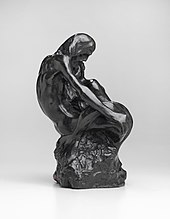Glaucus (sculpture)
 From Wikipedia - Reading time: 6 min
From Wikipedia - Reading time: 6 min
| Glaucus | |
|---|---|
 Bronze version, Museo Soumaya, Mexico City | |
| Artist | Auguste Rodin |
| Year | 1889 |
| Medium | Plaster, later bronze |
Glaucus is a sculpture by the French artist Auguste Rodin, first conceived in 1886 as a representation of the mythological figure Glaucus, son of Poseidon. Originally made in plaster, bronze casts of it are now in the Brooklyn Museum and the Museo Soumaya.
Inspiration
[edit]It was one of many studies arising from Rodin's reading of Ovid's Metamorphoses, here drawing on Book XIV, 1-74.[1] It adds a female figure to the male figure from Seated Old Man in order to represent the myth of Glaucus and Scylla,[2] meaning that it departs from the original myth in that both figures have human not monstrous legs. According to Bartlett, the work suggests that Glaucus is instead turning into a tree.[a]
Versions
[edit]
Brooklyn Museum
There is a variant of it shows a woman leaning her head to the man's chest and so in known as The Confidence or Confiding. It also appears twice on Rodin's The Gates of Hell, both times with the figure resting on his back.[3]
See also
[edit]Notes
[edit]- ^ Elsen cites Truman Bartlett: "Truman Bartlett saw the seated man in the doors and wrote, "The grave old being that sits with his legs well apart and rests his hands on his knees represents a man turning into a tree. On the door his back is towards the observer, and while going through his peacefully transforming process, he contentedly views the agitated panorama that stretches out in endless vista before him"
References
[edit]- ^ (in Spanish) Museo Soumaya (2015). Fundación Carlos Slim, ed. Colección Museo Soumaya 2. México. p. 122. ISBN 9786077805137.
- ^ de Roos, Hans (14 September 2009). "Glaucus". Rodin-web.org
- ^ Elsen, Albert Edward; Jamison, Rosalyn Frankel (2002-2003). Bernard Barryte, ed. Rodin's Art: the Iris & B. Gerald Cantor Collection at Stanford University New York: Oxford University Press. pp. 273-275.
External links
[edit] Media related to Glaucus by Auguste Rodin at Wikimedia Commons
Media related to Glaucus by Auguste Rodin at Wikimedia Commons
 KSF
KSF